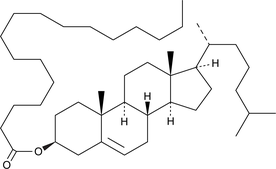Chemicals
Showing 14551–14700 of 41137 results
-
Cholesteryl hemisuccinate is a cholesterol ester with anticancer activity.{36854} It inhibits the growth of murine C1498 myeloid and L1210 lymphocytic leukemia cells when used at concentrations of 50 and 150 μM, respectively.{36854} Cholesteryl hemisuccinate acts as an ionizable anionic detergent and is commonly used to stabilize unilamellar vesicles and liposomes.{36855} It has also been used as an emulsifying agent in various vesicular drug delivery systems for anticancer drugs, antibiotics, and oligonucleotides and to solubilize various proteins including chemokine receptor 1 as well as erythrocyte ghosts.{24443,36856,36857}
Brand:CaymanSKU:25698 - 1 gAvailable on backorder
Cholesteryl hemisuccinate is a cholesterol ester with anticancer activity.{36854} It inhibits the growth of murine C1498 myeloid and L1210 lymphocytic leukemia cells when used at concentrations of 50 and 150 μM, respectively.{36854} Cholesteryl hemisuccinate acts as an ionizable anionic detergent and is commonly used to stabilize unilamellar vesicles and liposomes.{36855} It has also been used as an emulsifying agent in various vesicular drug delivery systems for anticancer drugs, antibiotics, and oligonucleotides and to solubilize various proteins including chemokine receptor 1 as well as erythrocyte ghosts.{24443,36856,36857}
Brand:CaymanSKU:25698 - 10 gAvailable on backorder
Cholesteryl hemisuccinate is a cholesterol ester with anticancer activity.{36854} It inhibits the growth of murine C1498 myeloid and L1210 lymphocytic leukemia cells when used at concentrations of 50 and 150 μM, respectively.{36854} Cholesteryl hemisuccinate acts as an ionizable anionic detergent and is commonly used to stabilize unilamellar vesicles and liposomes.{36855} It has also been used as an emulsifying agent in various vesicular drug delivery systems for anticancer drugs, antibiotics, and oligonucleotides and to solubilize various proteins including chemokine receptor 1 as well as erythrocyte ghosts.{24443,36856,36857}
Brand:CaymanSKU:25698 - 25 gAvailable on backorder
Cholesteryl hemisuccinate is a cholesterol ester with anticancer activity.{36854} It inhibits the growth of murine C1498 myeloid and L1210 lymphocytic leukemia cells when used at concentrations of 50 and 150 μM, respectively.{36854} Cholesteryl hemisuccinate acts as an ionizable anionic detergent and is commonly used to stabilize unilamellar vesicles and liposomes.{36855} It has also been used as an emulsifying agent in various vesicular drug delivery systems for anticancer drugs, antibiotics, and oligonucleotides and to solubilize various proteins including chemokine receptor 1 as well as erythrocyte ghosts.{24443,36856,36857}
Brand:CaymanSKU:25698 - 5 gAvailable on backorder
Cholesteryl heptadecanoate is a cholesterol ester (CE) formed by the condensation of cholesterol with heptadecanoic acid, a C-17 saturated fatty acid that does not occur in any natural animal or vegetable fat at high concentrations.{34595} As such, it is commonly used as an internal standard for the quantification of cholesterol esters by GC- or LC-mass spectrometry. CEs are major constituents of lipoprotein particles carried in blood and accumulate in the fatty acid lesions of atherosclerotic plaques.{34591,34594} CEs of various fatty acids are major constituents of murine and human adrenal glands.{34592}
Brand:CaymanSKU:21750 -Out of stock
Cholesteryl heptadecanoate is a cholesterol ester (CE) formed by the condensation of cholesterol with heptadecanoic acid, a C-17 saturated fatty acid that does not occur in any natural animal or vegetable fat at high concentrations.{34595} As such, it is commonly used as an internal standard for the quantification of cholesterol esters by GC- or LC-mass spectrometry. CEs are major constituents of lipoprotein particles carried in blood and accumulate in the fatty acid lesions of atherosclerotic plaques.{34591,34594} CEs of various fatty acids are major constituents of murine and human adrenal glands.{34592}
Brand:CaymanSKU:21750 -Out of stock
Cholesteryl heptadecanoate is a cholesterol ester (CE) formed by the condensation of cholesterol with heptadecanoic acid, a C-17 saturated fatty acid that does not occur in any natural animal or vegetable fat at high concentrations.{34595} As such, it is commonly used as an internal standard for the quantification of cholesterol esters by GC- or LC-mass spectrometry. CEs are major constituents of lipoprotein particles carried in blood and accumulate in the fatty acid lesions of atherosclerotic plaques.{34591,34594} CEs of various fatty acids are major constituents of murine and human adrenal glands.{34592}
Brand:CaymanSKU:21750 -Out of stock
Cholesteryl heptadecanoate is a cholesterol ester (CE) formed by the condensation of cholesterol with heptadecanoic acid, a C-17 saturated fatty acid that does not occur in any natural animal or vegetable fat at high concentrations.{34595} As such, it is commonly used as an internal standard for the quantification of cholesterol esters by GC- or LC-mass spectrometry. CEs are major constituents of lipoprotein particles carried in blood and accumulate in the fatty acid lesions of atherosclerotic plaques.{34591,34594} CEs of various fatty acids are major constituents of murine and human adrenal glands.{34592}
Brand:CaymanSKU:21750 -Out of stock
Cholesteryl homo-γ-linolenate is a cholesterol ester. It accumulates in the adrenal gland of rabbits fed a diet high in linolenic acid.{49041} Levels of cholesteryl homo-γ-linolenate are decreased and positively correlate with cognitive decline in HIV-infected humans.{49042}
Brand:CaymanSKU:26469 - 1 mgAvailable on backorder
Cholesteryl homo-γ-linolenate is a cholesterol ester. It accumulates in the adrenal gland of rabbits fed a diet high in linolenic acid.{49041} Levels of cholesteryl homo-γ-linolenate are decreased and positively correlate with cognitive decline in HIV-infected humans.{49042}
Brand:CaymanSKU:26469 - 10 mgAvailable on backorder
Cholesteryl homo-γ-linolenate is a cholesterol ester. It accumulates in the adrenal gland of rabbits fed a diet high in linolenic acid.{49041} Levels of cholesteryl homo-γ-linolenate are decreased and positively correlate with cognitive decline in HIV-infected humans.{49042}
Brand:CaymanSKU:26469 - 25 mgAvailable on backorder
Cholesteryl homo-γ-linolenate is a cholesterol ester. It accumulates in the adrenal gland of rabbits fed a diet high in linolenic acid.{49041} Levels of cholesteryl homo-γ-linolenate are decreased and positively correlate with cognitive decline in HIV-infected humans.{49042}
Brand:CaymanSKU:26469 - 5 mgAvailable on backorder
Cholesteryl lignocerate is a cholesterol ester that has been found in human meibum.{47142} Cholesteryl lignocerate can be hydrolyzed by cellular extracts from cultured human skin fibroblasts isolated from healthy individuals but not patients with cholesteryl ester storage disease (CESD) or Wolman disease.{48151}
Brand:CaymanSKU:26470 - 10 mgAvailable on backorder
Cholesteryl lignocerate is a cholesterol ester that has been found in human meibum.{47142} Cholesteryl lignocerate can be hydrolyzed by cellular extracts from cultured human skin fibroblasts isolated from healthy individuals but not patients with cholesteryl ester storage disease (CESD) or Wolman disease.{48151}
Brand:CaymanSKU:26470 - 25 mgAvailable on backorder
Cholesteryl lignocerate is a cholesterol ester that has been found in human meibum.{47142} Cholesteryl lignocerate can be hydrolyzed by cellular extracts from cultured human skin fibroblasts isolated from healthy individuals but not patients with cholesteryl ester storage disease (CESD) or Wolman disease.{48151}
Brand:CaymanSKU:26470 - 5 mgAvailable on backorder
Cholesteryl lignocerate is a cholesterol ester that has been found in human meibum.{47142} Cholesteryl lignocerate can be hydrolyzed by cellular extracts from cultured human skin fibroblasts isolated from healthy individuals but not patients with cholesteryl ester storage disease (CESD) or Wolman disease.{48151}
Brand:CaymanSKU:26470 - 50 mgAvailable on backorder
Cholesteryl linoleate is a cholesterol ester found in LDL.{38440} Cholesteryl linoleate is transferred to the plasma membrane of macrophages and CHO cells expressing 15-lipoxygenase (15-LO) via LDL receptor-related protein (LRP), where it undergoes oxidation to form cholesteryl linoleate hydroperoxides (Item No. 48001). Cholesteryl linoleate expression increases 2.7-fold in Apob-lipoproteins in mice overexpressing the human ABCA1 reverse cholesterol transporter, directly correlating with increased levels of hepatic cholesterol and number of atherosclerotic lesions.{38441}
Brand:CaymanSKU:22597 -Out of stock
Cholesteryl linoleate is a cholesterol ester found in LDL.{38440} Cholesteryl linoleate is transferred to the plasma membrane of macrophages and CHO cells expressing 15-lipoxygenase (15-LO) via LDL receptor-related protein (LRP), where it undergoes oxidation to form cholesteryl linoleate hydroperoxides (Item No. 48001). Cholesteryl linoleate expression increases 2.7-fold in Apob-lipoproteins in mice overexpressing the human ABCA1 reverse cholesterol transporter, directly correlating with increased levels of hepatic cholesterol and number of atherosclerotic lesions.{38441}
Brand:CaymanSKU:22597 -Out of stock
Cholesteryl linoleate is a cholesterol ester found in LDL.{38440} Cholesteryl linoleate is transferred to the plasma membrane of macrophages and CHO cells expressing 15-lipoxygenase (15-LO) via LDL receptor-related protein (LRP), where it undergoes oxidation to form cholesteryl linoleate hydroperoxides (Item No. 48001). Cholesteryl linoleate expression increases 2.7-fold in Apob-lipoproteins in mice overexpressing the human ABCA1 reverse cholesterol transporter, directly correlating with increased levels of hepatic cholesterol and number of atherosclerotic lesions.{38441}
Brand:CaymanSKU:22597 -Out of stock
Cholesteryl linoleate is a cholesterol ester found in LDL.{38440} Cholesteryl linoleate is transferred to the plasma membrane of macrophages and CHO cells expressing 15-lipoxygenase (15-LO) via LDL receptor-related protein (LRP), where it undergoes oxidation to form cholesteryl linoleate hydroperoxides (Item No. 48001). Cholesteryl linoleate expression increases 2.7-fold in Apob-lipoproteins in mice overexpressing the human ABCA1 reverse cholesterol transporter, directly correlating with increased levels of hepatic cholesterol and number of atherosclerotic lesions.{38441}
Brand:CaymanSKU:22597 -Out of stock
Cholesteryl myristate is a cholesterol ester.{49007} Levels of cholesteryl myristate are increased in the serum, liver, and aorta in rabbits fed a high-cholesterol diet and positively correlate with development of non-alcoholic fatty liver disease (NAFLD). Plasma levels of cholesteryl myristate also positively correlate with the presence of unstable atherosclerotic plaques in coronary artery disease.{49008} Cholesterol myristate has been used in the composition of lipid nanoparticles as drug carrier systems for drugs with low water solubility.{36419}
Brand:CaymanSKU:26439 - 1 gAvailable on backorder
Cholesteryl myristate is a cholesterol ester.{49007} Levels of cholesteryl myristate are increased in the serum, liver, and aorta in rabbits fed a high-cholesterol diet and positively correlate with development of non-alcoholic fatty liver disease (NAFLD). Plasma levels of cholesteryl myristate also positively correlate with the presence of unstable atherosclerotic plaques in coronary artery disease.{49008} Cholesterol myristate has been used in the composition of lipid nanoparticles as drug carrier systems for drugs with low water solubility.{36419}
Brand:CaymanSKU:26439 - 500 mgAvailable on backorder
Cholesteryl oleate is a cholesterol ester.{43911,45131} It has been used in the generation of nanoparticles and liposomes for drug delivery.
Brand:CaymanSKU:26472 - 100 mgAvailable on backorder
Cholesteryl oleate is a cholesterol ester.{43911,45131} It has been used in the generation of nanoparticles and liposomes for drug delivery.
Brand:CaymanSKU:26472 - 250 mgAvailable on backorder
Cholesteryl oleate is a cholesterol ester.{43911,45131} It has been used in the generation of nanoparticles and liposomes for drug delivery.
Brand:CaymanSKU:26472 - 50 mgAvailable on backorder
Cholesteryl oleate is a cholesterol ester.{43911,45131} It has been used in the generation of nanoparticles and liposomes for drug delivery.
Brand:CaymanSKU:26472 - 500 mgAvailable on backorder
Cholesteryl palmitate is a cholesterol ester. It is a major cholesterol ester found in human meibum and has been used to form a stable tear film to study amphiphilic block copolymers as surfactants for dry eyes.{45234} Cholesteryl palmitate levels in amniotic fluid are decreased in pregnancies in which infants later developed respiratory distress syndrome and in patients with well-controlled diabetes.{45235,45236} Levels of cholesteryl palmitate are increased in bronchoalveolar lavage fluid (BALF) from patients with chronic interstitial pneumonia.{45237}
Brand:CaymanSKU:26473 - 1 gAvailable on backorder
Cholesteryl palmitate is a cholesterol ester. It is a major cholesterol ester found in human meibum and has been used to form a stable tear film to study amphiphilic block copolymers as surfactants for dry eyes.{45234} Cholesteryl palmitate levels in amniotic fluid are decreased in pregnancies in which infants later developed respiratory distress syndrome and in patients with well-controlled diabetes.{45235,45236} Levels of cholesteryl palmitate are increased in bronchoalveolar lavage fluid (BALF) from patients with chronic interstitial pneumonia.{45237} Cholesteryl palmitate MaxSpec® standard is a quantitative grade standard of cholesteryl palmitate (Item No. 26473) that has been prepared specifically for mass spectrometry and related applications where quantitative reproducibility is required. The solution has been prepared gravimetrically and is supplied in a deactivated glass ampule sealed under argon. The concentration was verified by comparison to an independently prepared calibration standard. This cholesteryl palmitate MaxSpec® standard is guaranteed to meet identity, purity, stability, and concentration specifications and is provided with a batch-specific certificate of analysis. Ongoing stability testing is performed to ensure the concentration remains accurate throughout the shelf life of the product. Note: The amount of solution added to the vial is in excess of the listed amount. Therefore, it is necessary to accurately measure volumes for preparation of calibration standards. Follow recommended storage and handling conditions to maintain product quality.
Brand:CaymanSKU:30250 - 100 µgAvailable on backorder
Cholesteryl palmitoleate is a cholesterol ester.{42811,47069,42812} Plasma levels of cholesteryl palmitoleate are increased in ApoE-/- mice exposed to cigarette smoke and in pediatric patients with biliary atresia.{42811,47069} Cholesteryl palmitoleate has been used as a standard for the identification of cholesterol esters in human meibomian gland secretions.{42812}
Brand:CaymanSKU:26474 - 100 mgAvailable on backorder
Cholesteryl palmitoleate is a cholesterol ester.{42811,47069,42812} Plasma levels of cholesteryl palmitoleate are increased in ApoE-/- mice exposed to cigarette smoke and in pediatric patients with biliary atresia.{42811,47069} Cholesteryl palmitoleate has been used as a standard for the identification of cholesterol esters in human meibomian gland secretions.{42812}
Brand:CaymanSKU:26474 - 250 mgAvailable on backorder
Cholesteryl palmitoleate is a cholesterol ester.{42811,47069,42812} Plasma levels of cholesteryl palmitoleate are increased in ApoE-/- mice exposed to cigarette smoke and in pediatric patients with biliary atresia.{42811,47069} Cholesteryl palmitoleate has been used as a standard for the identification of cholesterol esters in human meibomian gland secretions.{42812}
Brand:CaymanSKU:26474 - 50 mgAvailable on backorder
Cholesteryl palmitoleate is a cholesterol ester.{42811,47069,42812} Plasma levels of cholesteryl palmitoleate are increased in ApoE-/- mice exposed to cigarette smoke and in pediatric patients with biliary atresia.{42811,47069} Cholesteryl palmitoleate has been used as a standard for the identification of cholesterol esters in human meibomian gland secretions.{42812}
Brand:CaymanSKU:26474 - 500 mgAvailable on backorder
Cholesteryl stearate is a cholesterol ester.{47414} It has been used as an internal standard for the quantification of sterol esters in various plant tissues by quadropole time-of-flight (Q-TOF) MS. Cholesteryl stearate levels are decreased in coronary arteries with atherosclerotic plaques, isolated fatty streaks, and isolated atherosclerotic plaques compared with non-atherosclerotic coronary arteries.{47415}
Brand:CaymanSKU:26475 - 250 mgAvailable on backorder
Cholesteryl stearate is a cholesterol ester.{47414} It has been used as an internal standard for the quantification of sterol esters in various plant tissues by quadropole time-of-flight (Q-TOF) MS. Cholesteryl stearate levels are decreased in coronary arteries with atherosclerotic plaques, isolated fatty streaks, and isolated atherosclerotic plaques compared with non-atherosclerotic coronary arteries.{47415}
Brand:CaymanSKU:26475 - 500 mgAvailable on backorder
Cholic acid is a major primary bile acid produced in the liver and usually conjugated with glycine or taurine to form bile salts.{30859} Cholic acid facilitates fat absorption and cholesterol excretion.{8343,29716}
Brand:CaymanSKU:20250 -Available on backorder
Cholic acid is a major primary bile acid produced in the liver and usually conjugated with glycine or taurine to form bile salts.{30859} Cholic acid facilitates fat absorption and cholesterol excretion.{8343,29716}
Brand:CaymanSKU:20250 -Available on backorder
Cholic acid is a major primary bile acid produced in the liver and usually conjugated with glycine or taurine to form bile salts.{30859} Cholic acid facilitates fat absorption and cholesterol excretion.{8343,29716}
Brand:CaymanSKU:20250 -Available on backorder
Cholic acid is a major primary bile acid produced in the liver and usually conjugated with glycine or taurine to form bile salts.{30859} Cholic acid facilitates fat absorption and cholesterol excretion.{8343,29716}
Brand:CaymanSKU:20250 -Available on backorder
Cholic acid 7-sulfate is a metabolite of the primary bile acid cholic acid (Item No. 20250).{30822,30823} It is produced by conjugation of a sulfate group with the hydroxy group at position 7 of cholic acid in the liver and gut. Fecal levels of cholic acid 7-sulfate are increased in male, but not female, mice fed a diet supplemented with cholic acid or chenodeoxycholic acid (Item No. 10011286).{30823}
Brand:CaymanSKU:9002532 - 1 mgAvailable on backorder
Cholic acid 7-sulfate is a metabolite of the primary bile acid cholic acid (Item No. 20250).{30822,30823} It is produced by conjugation of a sulfate group with the hydroxy group at position 7 of cholic acid in the liver and gut. Fecal levels of cholic acid 7-sulfate are increased in male, but not female, mice fed a diet supplemented with cholic acid or chenodeoxycholic acid (Item No. 10011286).{30823}
Brand:CaymanSKU:9002532 - 10 mgAvailable on backorder
Cholic acid 7-sulfate is a metabolite of the primary bile acid cholic acid (Item No. 20250).{30822,30823} It is produced by conjugation of a sulfate group with the hydroxy group at position 7 of cholic acid in the liver and gut. Fecal levels of cholic acid 7-sulfate are increased in male, but not female, mice fed a diet supplemented with cholic acid or chenodeoxycholic acid (Item No. 10011286).{30823}
Brand:CaymanSKU:9002532 - 5 mgAvailable on backorder
Cholic acid 7-sulfate is a metabolite of the primary bile acid cholic acid (Item No. 20250).{30822,30823} It is produced by conjugation of a sulfate group with the hydroxy group at position 7 of cholic acid in the liver and gut. Fecal levels of cholic acid 7-sulfate are increased in male, but not female, mice fed a diet supplemented with cholic acid or chenodeoxycholic acid (Item No. 10011286).{30823}
Brand:CaymanSKU:9002532 - 500 µgAvailable on backorder
Cholic acid anilide is a synthetic bile acid and derivative of cholic acid (Item No. 20250) that inhibits the germination of C. difficile strain R20291 spores in vitro (IC50 = 1.8 μM).{44014}
Brand:CaymanSKU:26144 - 10 mgAvailable on backorder
Cholic acid anilide is a synthetic bile acid and derivative of cholic acid (Item No. 20250) that inhibits the germination of C. difficile strain R20291 spores in vitro (IC50 = 1.8 μM).{44014}
Brand:CaymanSKU:26144 - 25 mgAvailable on backorder
Cholic acid anilide is a synthetic bile acid and derivative of cholic acid (Item No. 20250) that inhibits the germination of C. difficile strain R20291 spores in vitro (IC50 = 1.8 μM).{44014}
Brand:CaymanSKU:26144 - 5 mgAvailable on backorder
Cholic acid anilide is a synthetic bile acid and derivative of cholic acid (Item No. 20250) that inhibits the germination of C. difficile strain R20291 spores in vitro (IC50 = 1.8 μM).{44014}
Brand:CaymanSKU:26144 - 50 mgAvailable on backorder
Cholic acid is a major primary bile acid produced in the liver and usually conjugated with glycine or taurine to form bile salts.{30859} Cholic acid facilitates fat absorption and cholesterol excretion.{8343,29716} Cholic acid MaxSpec® standard is a quantitative grade standard of cholic acid (Item No. 20250) that has been prepared specifically for mass spectrometry and related applications where quantitative reproducibility is required. The solution has been prepared gravimetrically and is supplied in a deactivated glass ampule sealed under argon. The concentration was verified by comparison to an independently prepared calibration standard. This cholic acid MaxSpec® standard is guaranteed to meet identity, purity, stability, and concentration specifications and is provided with a batch-specific certificate of analysis. Ongoing stability testing is performed to ensure the concentration remains accurate throughout the shelf life of the product. Note: The amount of solution added to the vial is in excess of the listed amount. Therefore, it is necessary to accurately measure volumes for preparation of calibration standards. Follow recommended storage and handling conditions to maintain product quality.
Brand:CaymanSKU:31347 - 100 µgAvailable on backorder
Cholic acid-d4 contains four deuterium atoms at the 2, 2, 4, and 4 positions. It is intended for use as an internal standard for the quantification of cholic acid (Item No. 20250) by GC- or LC-MS. Cholic acid is a major primary bile acid produced in the liver and usually conjugated with glycine or taurine to form bile salts.{30859} Cholic acid facilitates fat absorption and cholesterol excretion.{8343,29716}
Brand:CaymanSKU:20849 -Out of stock
Cholic acid-d4 contains four deuterium atoms at the 2, 2, 4, and 4 positions. It is intended for use as an internal standard for the quantification of cholic acid (Item No. 20250) by GC- or LC-MS. Cholic acid is a major primary bile acid produced in the liver and usually conjugated with glycine or taurine to form bile salts.{30859} Cholic acid facilitates fat absorption and cholesterol excretion.{8343,29716}
Brand:CaymanSKU:20849 -Out of stock
Cholic acid-d4 contains four deuterium atoms at the 2, 2, 4, and 4 positions. It is intended for use as an internal standard for the quantification of cholic acid (Item No. 20250) by GC- or LC-MS. Cholic acid is a major primary bile acid produced in the liver and usually conjugated with glycine or taurine to form bile salts.{30859} Cholic acid facilitates fat absorption and cholesterol excretion.{8343,29716}
Brand:CaymanSKU:20849 -Out of stock
Choline is an essential nutrient with roles in liver, neurological, hematological, and skeletal muscle homeostasis.{58015,58016,58014,58013} It is a precursor in the biosynthesis of membrane phospholipids, such as phosphatidylcholine, which facilitate cell signaling and transport across the membrane, and a precursor to the neurotransmitter acetylcholine. Choline is required for hepatic lipid transport.{58015} Perinatal administration of choline (18.8 mg/kg) improves prenatal alcohol exposure-induced cognitive deficits in rats.{58016} Choline (13 mg/animal per day) improves motor coordination and behavioral deficits in a mouse model of Rett syndrome, as well as improves deficits in recognition memory induced by early-life iron deficiency in rats when administered in the drinking water at a concentration of 5 ppm.{58014} Deficiencies in choline intake are positively correlated with muscle wasting, and dietary administration of choline (1,000 mg/kg) increases leg and breast muscle protein content in broiler chickens.{58013}
Brand:CaymanSKU:31178 - 100 gAvailable on backorder
Choline is an essential nutrient with roles in liver, neurological, hematological, and skeletal muscle homeostasis.{58015,58016,58014,58013} It is a precursor in the biosynthesis of membrane phospholipids, such as phosphatidylcholine, which facilitate cell signaling and transport across the membrane, and a precursor to the neurotransmitter acetylcholine. Choline is required for hepatic lipid transport.{58015} Perinatal administration of choline (18.8 mg/kg) improves prenatal alcohol exposure-induced cognitive deficits in rats.{58016} Choline (13 mg/animal per day) improves motor coordination and behavioral deficits in a mouse model of Rett syndrome, as well as improves deficits in recognition memory induced by early-life iron deficiency in rats when administered in the drinking water at a concentration of 5 ppm.{58014} Deficiencies in choline intake are positively correlated with muscle wasting, and dietary administration of choline (1,000 mg/kg) increases leg and breast muscle protein content in broiler chickens.{58013}
Brand:CaymanSKU:31178 - 250 gAvailable on backorder
Choline is an essential nutrient with roles in liver, neurological, hematological, and skeletal muscle homeostasis.{58015,58016,58014,58013} It is a precursor in the biosynthesis of membrane phospholipids, such as phosphatidylcholine, which facilitate cell signaling and transport across the membrane, and a precursor to the neurotransmitter acetylcholine. Choline is required for hepatic lipid transport.{58015} Perinatal administration of choline (18.8 mg/kg) improves prenatal alcohol exposure-induced cognitive deficits in rats.{58016} Choline (13 mg/animal per day) improves motor coordination and behavioral deficits in a mouse model of Rett syndrome, as well as improves deficits in recognition memory induced by early-life iron deficiency in rats when administered in the drinking water at a concentration of 5 ppm.{58014} Deficiencies in choline intake are positively correlated with muscle wasting, and dietary administration of choline (1,000 mg/kg) increases leg and breast muscle protein content in broiler chickens.{58013}
Brand:CaymanSKU:31178 - 50 gAvailable on backorder
Choline is an essential nutrient with roles in liver, neurological, hematological, and skeletal muscle homeostasis.{58015,58016,58014,58013} It is a precursor in the biosynthesis of membrane phospholipids, such as phosphatidylcholine, which facilitate cell signaling and transport across the membrane, and a precursor to the neurotransmitter acetylcholine. Choline is required for hepatic lipid transport.{58015} Perinatal administration of choline (18.8 mg/kg) improves prenatal alcohol exposure-induced cognitive deficits in rats.{58016} Choline (13 mg/animal per day) improves motor coordination and behavioral deficits in a mouse model of Rett syndrome, as well as improves deficits in recognition memory induced by early-life iron deficiency in rats when administered in the drinking water at a concentration of 5 ppm.{58014} Deficiencies in choline intake are positively correlated with muscle wasting, and dietary administration of choline (1,000 mg/kg) increases leg and breast muscle protein content in broiler chickens.{58013}
Brand:CaymanSKU:31178 - 500 gAvailable on backorder
CHR-6494 is a haspin protein kinase inhibitor (IC50 = 2 nM) selective over 27 other protein kinases, including Aurora B kinase (IC50 > 1 µM). Haspin is a kinase necessary for mitosis that selectively phosphorylates histone 3 at the threonine 3 residue (H3T3ph).{20471} CHR-6494 decreases phosphorylation of H3T3 and arrests the cell cycle in the G2/M phase, which leads to apoptosis. It showed promising results in a xenograft tumor model.
Brand:CaymanSKU:11478 - 1 mgAvailable on backorder
CHR-6494 is a haspin protein kinase inhibitor (IC50 = 2 nM) selective over 27 other protein kinases, including Aurora B kinase (IC50 > 1 µM). Haspin is a kinase necessary for mitosis that selectively phosphorylates histone 3 at the threonine 3 residue (H3T3ph).{20471} CHR-6494 decreases phosphorylation of H3T3 and arrests the cell cycle in the G2/M phase, which leads to apoptosis. It showed promising results in a xenograft tumor model.
Brand:CaymanSKU:11478 - 10 mgAvailable on backorder
CHR-6494 is a haspin protein kinase inhibitor (IC50 = 2 nM) selective over 27 other protein kinases, including Aurora B kinase (IC50 > 1 µM). Haspin is a kinase necessary for mitosis that selectively phosphorylates histone 3 at the threonine 3 residue (H3T3ph).{20471} CHR-6494 decreases phosphorylation of H3T3 and arrests the cell cycle in the G2/M phase, which leads to apoptosis. It showed promising results in a xenograft tumor model.
Brand:CaymanSKU:11478 - 5 mgAvailable on backorder
Chrodrimanin B is a meroterpenoid fungal metabolite that has been found in Talaromyces species.{48232} It has insecticidal activity against third instar silkworm larvae (LD50 = 10 μg/g of diet). Chrodrimanin B selectively inhibits the silkworm GABA receptor RDL (IC50 = 1.13 nM) over human α1β2γ2 subunit-containing GABA receptors (IC50 = 1.48 μM).{48233} The structure of thailandolide B, originally described as a C-9 epimer of chrodrimanin B, was revised in 2012 and is identical to that of chrodrimanin B.{48232}
Brand:CaymanSKU:27585 - 1 mgAvailable on backorder
Chromanol 293B is a blocker of slowly activating delayed-rectifier K+ current (IKs) with an IC50 value of 6.89 μM in Xenopus oocytes expressing rat IKs channels.{38238} It is selective, having no activity at rat Kv1.1 or Kir2.1 channels at a concentration of 30 μM. Chromanol 293B increases the rate and extent of IKs in guinea pig ventricular cells in a dose-dependent manner.{38239} It also inhibits cystic fibrosis transmembrane conductance regulator (CTFR) Cl- currents (ICTFR) with an IC50 value of 19 μM in Xenopus oocytes expressing human CTFR.{38240}
Brand:CaymanSKU:19993 -Available on backorder
Chromanol 293B is a blocker of slowly activating delayed-rectifier K+ current (IKs) with an IC50 value of 6.89 μM in Xenopus oocytes expressing rat IKs channels.{38238} It is selective, having no activity at rat Kv1.1 or Kir2.1 channels at a concentration of 30 μM. Chromanol 293B increases the rate and extent of IKs in guinea pig ventricular cells in a dose-dependent manner.{38239} It also inhibits cystic fibrosis transmembrane conductance regulator (CTFR) Cl- currents (ICTFR) with an IC50 value of 19 μM in Xenopus oocytes expressing human CTFR.{38240}
Brand:CaymanSKU:19993 -Available on backorder
Chromanol 293B is a blocker of slowly activating delayed-rectifier K+ current (IKs) with an IC50 value of 6.89 μM in Xenopus oocytes expressing rat IKs channels.{38238} It is selective, having no activity at rat Kv1.1 or Kir2.1 channels at a concentration of 30 μM. Chromanol 293B increases the rate and extent of IKs in guinea pig ventricular cells in a dose-dependent manner.{38239} It also inhibits cystic fibrosis transmembrane conductance regulator (CTFR) Cl- currents (ICTFR) with an IC50 value of 19 μM in Xenopus oocytes expressing human CTFR.{38240}
Brand:CaymanSKU:19993 -Available on backorder
Chromanol 293B is a blocker of slowly activating delayed-rectifier K+ current (IKs) with an IC50 value of 6.89 μM in Xenopus oocytes expressing rat IKs channels.{38238} It is selective, having no activity at rat Kv1.1 or Kir2.1 channels at a concentration of 30 μM. Chromanol 293B increases the rate and extent of IKs in guinea pig ventricular cells in a dose-dependent manner.{38239} It also inhibits cystic fibrosis transmembrane conductance regulator (CTFR) Cl- currents (ICTFR) with an IC50 value of 19 μM in Xenopus oocytes expressing human CTFR.{38240}
Brand:CaymanSKU:19993 -Available on backorder
Chromomycin A2 is an aureolic acid that has been found in several marine actinomycetes and has antibacterial and anticancer activities.{46145,46146} Chromomycin A2 inhibits the growth of B. subtilis in an agar diffusion assay.{46145} It also inhibits the growth of human SGC7901 gastric cancer, HepG2 hepatocellular carcinoma, A549 lung epithelial adenocarcinoma, HCT116 colon cancer, and COC1 ovarian cancer cells, as well as human umbilical vein endothelial cells (HUVECs; IC50s = 4, 0.5, 3, 5, 5, and 8 nM, respectively).{46146} Chromomycin A2 (30 nM) halts the cell cycle in the G0/G1 phase and increases the protein levels of LC3A and LC3B in MALME-3M melanoma cells, indicating that it induces autophagy.{46147} It also increases the levels and promoter activity of the autophagic proteins ATG7 and ATG10 and reduces cell viability to 50% in human SCC-11 squamous cell carcinoma cells when used at a concentration of 30 nM.{46148}
Brand:CaymanSKU:26954 - 1 mgAvailable on backorder
Chromomycin A2 is an aureolic acid that has been found in several marine actinomycetes and has antibacterial and anticancer activities.{46145,46146} Chromomycin A2 inhibits the growth of B. subtilis in an agar diffusion assay.{46145} It also inhibits the growth of human SGC7901 gastric cancer, HepG2 hepatocellular carcinoma, A549 lung epithelial adenocarcinoma, HCT116 colon cancer, and COC1 ovarian cancer cells, as well as human umbilical vein endothelial cells (HUVECs; IC50s = 4, 0.5, 3, 5, 5, and 8 nM, respectively).{46146} Chromomycin A2 (30 nM) halts the cell cycle in the G0/G1 phase and increases the protein levels of LC3A and LC3B in MALME-3M melanoma cells, indicating that it induces autophagy.{46147} It also increases the levels and promoter activity of the autophagic proteins ATG7 and ATG10 and reduces cell viability to 50% in human SCC-11 squamous cell carcinoma cells when used at a concentration of 30 nM.{46148}
Brand:CaymanSKU:26954 - 5 mgAvailable on backorder
Chromomycin A3 is an anthraquinone antibiotic and antitumor agent isolated from S. griseus that is used as a fluorescent probe for DNA with excitation/emission spectra of 445/575 nm.{36032,36035} Its DNA binding is specific to two or more contiguous GC base pairs, which makes it suitable for characterizing heterochromatin in plants with species-specific AT:GC ratios.{36035,36031} Chromomycin A3 is cytotoxic against non-small cell lung cancer and cervical cancer in vitro (IC50s = 1, 42, 60, and 40 nM for HCC44, A549, ME180, and HeLa cells, respectively).{366034,31081} It also inhibits oxidative stress- and DNA damage-induced neuronal injury by enhancing Sp1 and Sp3 transcription factor binding.{36033}
Brand:CaymanSKU:11315 - 1 mgAvailable on backorder
Chromomycin A3 is an anthraquinone antibiotic and antitumor agent isolated from S. griseus that is used as a fluorescent probe for DNA with excitation/emission spectra of 445/575 nm.{36032,36035} Its DNA binding is specific to two or more contiguous GC base pairs, which makes it suitable for characterizing heterochromatin in plants with species-specific AT:GC ratios.{36035,36031} Chromomycin A3 is cytotoxic against non-small cell lung cancer and cervical cancer in vitro (IC50s = 1, 42, 60, and 40 nM for HCC44, A549, ME180, and HeLa cells, respectively).{366034,31081} It also inhibits oxidative stress- and DNA damage-induced neuronal injury by enhancing Sp1 and Sp3 transcription factor binding.{36033}
Brand:CaymanSKU:11315 - 5 mgAvailable on backorder
Chrysin is a natural flavonoid with antioxidant, anti-inflammatory, and anticancer properties. It blocks COX-2 gene expression, PGE2 production, and hydroxyl radical formation in LPS-induced RAW 264.7 cells.{28408,28409} Chrysin inhibits insulin-induced HIF-1α expression (~50% at 10 µM) in human prostate cancer DU145 cells and blocks DU145 xenograft-induced angiogenesis in vivo.{28410} In a mouse model of ischemia/reperfusion injury, chrysin decreased pro-inflammatory gene expression and oxidative stress, resulting in a reduction of infarct volume and neurological defects.{28411}
Brand:CaymanSKU:-Available on backorder
Chrysin is a natural flavonoid with antioxidant, anti-inflammatory, and anticancer properties. It blocks COX-2 gene expression, PGE2 production, and hydroxyl radical formation in LPS-induced RAW 264.7 cells.{28408,28409} Chrysin inhibits insulin-induced HIF-1α expression (~50% at 10 µM) in human prostate cancer DU145 cells and blocks DU145 xenograft-induced angiogenesis in vivo.{28410} In a mouse model of ischemia/reperfusion injury, chrysin decreased pro-inflammatory gene expression and oxidative stress, resulting in a reduction of infarct volume and neurological defects.{28411}
Brand:CaymanSKU:-Available on backorder
Chrysin is a natural flavonoid with antioxidant, anti-inflammatory, and anticancer properties. It blocks COX-2 gene expression, PGE2 production, and hydroxyl radical formation in LPS-induced RAW 264.7 cells.{28408,28409} Chrysin inhibits insulin-induced HIF-1α expression (~50% at 10 µM) in human prostate cancer DU145 cells and blocks DU145 xenograft-induced angiogenesis in vivo.{28410} In a mouse model of ischemia/reperfusion injury, chrysin decreased pro-inflammatory gene expression and oxidative stress, resulting in a reduction of infarct volume and neurological defects.{28411}
Brand:CaymanSKU:-Available on backorder
Chrysin is a natural flavonoid with antioxidant, anti-inflammatory, and anticancer properties. It blocks COX-2 gene expression, PGE2 production, and hydroxyl radical formation in LPS-induced RAW 264.7 cells.{28408,28409} Chrysin inhibits insulin-induced HIF-1α expression (~50% at 10 µM) in human prostate cancer DU145 cells and blocks DU145 xenograft-induced angiogenesis in vivo.{28410} In a mouse model of ischemia/reperfusion injury, chrysin decreased pro-inflammatory gene expression and oxidative stress, resulting in a reduction of infarct volume and neurological defects.{28411}
Brand:CaymanSKU:-Available on backorder
Chrysomycin A is an antibiotic isolated from a strain of Streptomyces.{22201} It is structurally very similar to gilvocarcin V, an inhibitor of topoisomerase II which promotes DNA cross-linking with histone 3 and GRP78 when photoactivated by near-UV light.{22203,22198,22200} Chrysomycin A inhibits DNA synthesis in bacteria and suppresses the growth of transplantable tumors in mice.{22202,22199}
Brand:CaymanSKU:-Chrysomycin A is an antibiotic isolated from a strain of Streptomyces.{22201} It is structurally very similar to gilvocarcin V, an inhibitor of topoisomerase II which promotes DNA cross-linking with histone 3 and GRP78 when photoactivated by near-UV light.{22203,22198,22200} Chrysomycin A inhibits DNA synthesis in bacteria and suppresses the growth of transplantable tumors in mice.{22202,22199}
Brand:CaymanSKU:-Chrysomycin B is an antibiotic isolated from a strain of Streptomyces.{22201} It differs from its analog chrysomycin A (Item No. 14188){22203,22199} by having a methyl, rather than vinyl, group in the 8-position of the chromophore. Like its analog, chrysomycin B suppresses the growth of transplantable tumors in mice, an effect that may be related to its ability to bind DNA.{22199,22204,22198} It also causes DNA damage in the human lung adenocarcinoma A549 cell line and inhibits topoisomerase II.{22198} Chrysomycin B is structurally very similar to gilvocarcin V, which promotes DNA cross-linking with histone 3 and GRP78 when photoactivated by near-UV light.{22200}
Brand:CaymanSKU:-Chrysomycin B is an antibiotic isolated from a strain of Streptomyces.{22201} It differs from its analog chrysomycin A (Item No. 14188){22203,22199} by having a methyl, rather than vinyl, group in the 8-position of the chromophore. Like its analog, chrysomycin B suppresses the growth of transplantable tumors in mice, an effect that may be related to its ability to bind DNA.{22199,22204,22198} It also causes DNA damage in the human lung adenocarcinoma A549 cell line and inhibits topoisomerase II.{22198} Chrysomycin B is structurally very similar to gilvocarcin V, which promotes DNA cross-linking with histone 3 and GRP78 when photoactivated by near-UV light.{22200}
Brand:CaymanSKU:-Chrysophanol is an anthraquinone that has been found in R. palmatum and has diverse biological activities.{31786,31785,31784} It induces necrosis in J5 human liver cancer cells when used at concentrations of 25, 50, 75, 100, and 200 µM.{31785} Chrysophanol (5, 10, and 50 µM) reduces LPS-induced production of nitric oxide (NO) and prostaglandin E2 (PGE2; Item No. 14010) and inhibits LPS-induced DNA oxidation in BV-2 microglia.{31784} In vivo, chrysophanol (5 mg/kg) decreases colonic levels of IL-6 and activation of NF-κB and reduces weight loss, diarrhea, and rectal bleeding in a mouse model of colitis induced by dextran sulfate (DSS; Item No. 23250).{59380} Chrysophanol (0.1, 1, and 10 mg/kg) increases survival, reduces brain tissue loss, and ameliorates motor balance deficits in a mouse model of ischemia-reperfusion injury induced by middle cerebral artery occlusion (MCAO).{59381}
Brand:CaymanSKU:19870 -Available on backorder
Chrysophanol is an anthraquinone that has been found in R. palmatum and has diverse biological activities.{31786,31785,31784} It induces necrosis in J5 human liver cancer cells when used at concentrations of 25, 50, 75, 100, and 200 µM.{31785} Chrysophanol (5, 10, and 50 µM) reduces LPS-induced production of nitric oxide (NO) and prostaglandin E2 (PGE2; Item No. 14010) and inhibits LPS-induced DNA oxidation in BV-2 microglia.{31784} In vivo, chrysophanol (5 mg/kg) decreases colonic levels of IL-6 and activation of NF-κB and reduces weight loss, diarrhea, and rectal bleeding in a mouse model of colitis induced by dextran sulfate (DSS; Item No. 23250).{59380} Chrysophanol (0.1, 1, and 10 mg/kg) increases survival, reduces brain tissue loss, and ameliorates motor balance deficits in a mouse model of ischemia-reperfusion injury induced by middle cerebral artery occlusion (MCAO).{59381}
Brand:CaymanSKU:19870 -Available on backorder
Chrysophanol is an anthraquinone that has been found in R. palmatum and has diverse biological activities.{31786,31785,31784} It induces necrosis in J5 human liver cancer cells when used at concentrations of 25, 50, 75, 100, and 200 µM.{31785} Chrysophanol (5, 10, and 50 µM) reduces LPS-induced production of nitric oxide (NO) and prostaglandin E2 (PGE2; Item No. 14010) and inhibits LPS-induced DNA oxidation in BV-2 microglia.{31784} In vivo, chrysophanol (5 mg/kg) decreases colonic levels of IL-6 and activation of NF-κB and reduces weight loss, diarrhea, and rectal bleeding in a mouse model of colitis induced by dextran sulfate (DSS; Item No. 23250).{59380} Chrysophanol (0.1, 1, and 10 mg/kg) increases survival, reduces brain tissue loss, and ameliorates motor balance deficits in a mouse model of ischemia-reperfusion injury induced by middle cerebral artery occlusion (MCAO).{59381}
Brand:CaymanSKU:19870 -Available on backorder
Chrysosplenetin is a flavonoid that has been found in A. annua and has diverse biological activities.{57215,57216,57217} It is active against P. falciparum in vitro (IC50 = 23 µM).{57215} Chrysosplenetin inhibits the cytopathic effect of enterovirus 71 (EV71) in Vero cells (EC50 = 0.68 µM) and increases survival in a neonatal mouse model of EV71 infection when administered at doses of 1 and 5 mg/kg.{57216} It also increases proliferation and osteogenic differentiation of isolated human bone marrow stromal cells (BMSCs) and prevents estrogen deficiency-induced bone loss in ovariectomized mice.{57217}
Brand:CaymanSKU:30625 - 1 mgAvailable on backorder
Chrysosplenetin is a flavonoid that has been found in A. annua and has diverse biological activities.{57215,57216,57217} It is active against P. falciparum in vitro (IC50 = 23 µM).{57215} Chrysosplenetin inhibits the cytopathic effect of enterovirus 71 (EV71) in Vero cells (EC50 = 0.68 µM) and increases survival in a neonatal mouse model of EV71 infection when administered at doses of 1 and 5 mg/kg.{57216} It also increases proliferation and osteogenic differentiation of isolated human bone marrow stromal cells (BMSCs) and prevents estrogen deficiency-induced bone loss in ovariectomized mice.{57217}
Brand:CaymanSKU:30625 - 10 mgAvailable on backorder
Chrysosplenetin is a flavonoid that has been found in A. annua and has diverse biological activities.{57215,57216,57217} It is active against P. falciparum in vitro (IC50 = 23 µM).{57215} Chrysosplenetin inhibits the cytopathic effect of enterovirus 71 (EV71) in Vero cells (EC50 = 0.68 µM) and increases survival in a neonatal mouse model of EV71 infection when administered at doses of 1 and 5 mg/kg.{57216} It also increases proliferation and osteogenic differentiation of isolated human bone marrow stromal cells (BMSCs) and prevents estrogen deficiency-induced bone loss in ovariectomized mice.{57217}
Brand:CaymanSKU:30625 - 5 mgAvailable on backorder
CHS-828 is a pyridyl cyanoguanidine anti-tumor agent that has been identified as a competitive inhibitor of Nampt as well as an inhibitor of NF-κB pathway activity.{20745,20747} CHS-828 has potent cytotoxic effects in human breast (IC50 = 7.3 nM) and lung cancer (IC50 = 0.5 nM) cells both in vitro and in vivo.{20744} In nude mice bearing human tumor xenografts, CHS-828, at 20-50 mg/kg/day, inhibits the growth of MCF-7 breast cancer tumors and induces regression of NYH small cell lung cancer tumors.{20744}
Brand:CaymanSKU:11021 - 10 mgAvailable on backorder



























